Posted by Cameron on 04.13.08 2:20 PM
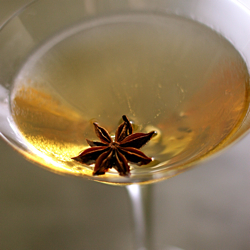 A month or so ago, at last unable to ignore the murmurs of delight circulating around the cocktail world, we sought out a bottle of Rhum Clément Creole Shrubb, an orange liqueur from Martinique. Made by infusing a blend of white and aged rums with spices and bitter orange peels, Creole Shrubb turns out to be quite different from the usual, more-neutral orange liqueurs. Its complexity intrigued us, but because we knew its dusky mysteriousness would make it an imperfect match for existing recipes, the Creole Shrubb languished on our “try me” shelf.
A month or so ago, at last unable to ignore the murmurs of delight circulating around the cocktail world, we sought out a bottle of Rhum Clément Creole Shrubb, an orange liqueur from Martinique. Made by infusing a blend of white and aged rums with spices and bitter orange peels, Creole Shrubb turns out to be quite different from the usual, more-neutral orange liqueurs. Its complexity intrigued us, but because we knew its dusky mysteriousness would make it an imperfect match for existing recipes, the Creole Shrubb languished on our “try me” shelf.
Last week, we received a bottle of Domaine de Canton, a ginger-cognac liqueur created by John Cooper (brother to Rob Cooper, creator of St. Germain) that has received a fair bit of positive press. As soon as I heard “ginger,” a light bulb went off in my head. Perhaps we’d finally found a companion for Creole Shrubb’s exotic overtones — and just in time for this month‘s fruit liqueur edition of Mixology Monday.
Creole Shrubb’s orange spice would be a natural match for the gingery Canton. Their families would get along, knit together by a shared history of tropical French colonialism: Creole Shrubb from les Antilles, Domaine de Canton with its roots in Indochine. Creole and Canton would fall in love and have beautiful little minibar bottles. Truly, I am the yenta of booze.
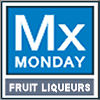
And yet, while the path to true love glowed ahead like a sunset on tropical shores, there was the danger this marriage of two sweet principals could become a sticky, sappy affair that would destroy itself in an explosion of pet names and babytalk. (“No, I wuv *you*, Cherie!”) Clearly, a sharp, antiseptic, perhaps even military chaperone was necessary — a no-nonsense personality to temper the flighty natures of our two romantics. I scanned the liquor cabinet and a grizzled naval officer stepped forward: Plymouth gin.
I must modestly admit that the first meeting of the three was a roaring success. I began by introducing them in equal amounts, reasoning that none would easily get the upper hand. These proportions turned out to be nearly ideal. When it seemed that the conversation could use a bit of lubricant, I blessed the vessel with a drop of bitters, and the addition brought the group together in even greater harmony.
Should you wish to arrange your own meeting, I have provided a guide below. If you must substitute, be prepared to tinker with the proportions. The penetrating sting of the Plymouth gin is especially (and surprisingly) important.

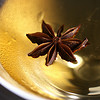



Asian Orange
1 oz Plymouth gin
1 oz Domaine de Canton
1 oz Rhum Clément Creole Shrubb
2 dashes Angostura bitters (or one dainty drop of Fee Brothers Whiskey Barrel Aged)
Combine in an ice-filled glass and stir until chilled. Strain into a chilled cocktail glass. Garnish with star anise, if desired.
Drink of the Week, drinks, Mixology Monday, recipes
8 Comments »




Posted by Anita on 03.17.08 8:29 PM
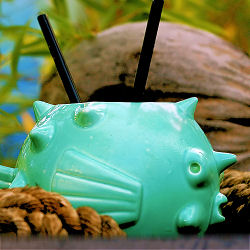 In his introduction to this month’s Mixology Monday festivities, our genial host Rick describes how he came up with the idea for his theme of “Limit One“:
In his introduction to this month’s Mixology Monday festivities, our genial host Rick describes how he came up with the idea for his theme of “Limit One“:
“Exotic cocktail spots would often advertise their potent potions by limiting a customer to one per evening. It wasn’t all gimmick, however; some recipes like the Zombie contained up to 5oz of 80-proof spirit! This phenomenon isn’t limited to just tiki drinks; in fact, many locales even have laws that forbid a bartender to create a drink with more than a specified quantity of liquor.”
Well, these sorts of potent potations may not necessarily be limited to tropical concoctions, but it’s hard to avoid the correlation: If the bar name includes an island locale and/or the word “Trader” in its name, the chances are pretty good that you’ll find some pretty strong stuff at the bottom of the menu.
 Mercifully, many of these voluminous drinks come equipped with two or more straws, and most are expressly designed to be shared by gregarious group of cocktail hounds. Among this genre, the best known — and possibly the most confusingly varied — is the Scorpion Bowl. Back in the tiki heyday of the 1950s, it seemed like every bartender had his own scorpion style; some stuck with the arguably original rum and brandy; others went straight for the jugular with gin and/or vodka, and still others just threw together any random combination of high-proof booze in a bowl with sweet syrups, colorful liqueurs, and a tropical fruit garnish. With bartenders like these, it’s a miracle that anyone survived to tell the tale, much less that the Scorpion Bowl is remembered — and reinvented — so fondly in the modern mixology world.
Mercifully, many of these voluminous drinks come equipped with two or more straws, and most are expressly designed to be shared by gregarious group of cocktail hounds. Among this genre, the best known — and possibly the most confusingly varied — is the Scorpion Bowl. Back in the tiki heyday of the 1950s, it seemed like every bartender had his own scorpion style; some stuck with the arguably original rum and brandy; others went straight for the jugular with gin and/or vodka, and still others just threw together any random combination of high-proof booze in a bowl with sweet syrups, colorful liqueurs, and a tropical fruit garnish. With bartenders like these, it’s a miracle that anyone survived to tell the tale, much less that the Scorpion Bowl is remembered — and reinvented — so fondly in the modern mixology world.
At Alameda’s Forbidden Island, there’s no shortage of high-octane cocktails. Yes, you’ll even find a Scorpion Bowl: Show up on Sundays, and you can share one with your friends for a mere $15. Theirs is a potent elixir, and quite the show to boot: A flaming crouton simulates lava spewing forth from the crater of the bowl’s volcano centerpiece. True to its origins, this scorpion’s sting will surely make you — and, hopefully, three of your closest friends — forget all of your cares… and maybe your name.
But for my money, the tastier option is a Forbidden Island exclusive known as the Fugu for Two. Even though it’s served in an adorable Munktiki fish-bowl, it’s hard to imagine how anyone other than a tiki fanatic would think that a couples’ cocktail served from the belly of a ceramic pufferfish is romantic. (‘Til death do us part, anyone?) But the drink itself is as delicious as it is strong: Fruity and tropical, but not sickly sweet. It’s as potent as its Scorpion sibiling, yes, but it’s more than a little civilized.
For those of you who can’t make it to Alameda, the Fugu tastes just as nice when served in a regular bowl — or even a pair of double Old Fashioned glasses, in a pinch — as it does when it’s poured into a jumbo collectible mug. And unlike its aquatic namesake, you don’t even need a special license to prepare this Fugu.


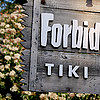
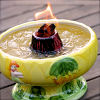

Fugu for Two
3 oz amber rum
1 oz vodka
1 oz apricot brandy
2 oz pineapple juice
1-1/2 oz fresh lemon juice
1 oz passion fruit syrup (preferably Monin)
1 oz orgeat
sparkling wine
Combine all ingredients in a blender with two cups of cracked ice and pulse twice, very quickly. Pour into a tall bowl. and add more cracked ice to fill. Top with a float of sparkling wine, and serve with two straws.
bar culture, drinks, East Bay, Mixology Monday, recipes
14 Comments »




Posted by Anita on 02.08.08 12:01 PM
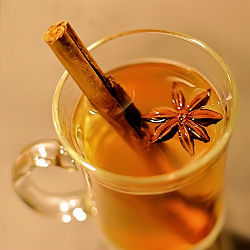 The fall that Cameron and I started dating was a brutal season. Everyone we knew seemed to have one of those colds that catches you in its grip and refuses to let go. The sound of coughing and sneezing was everywhere, and it seemed like the whole city of San Francisco had a red nose and bags under its eyes.
The fall that Cameron and I started dating was a brutal season. Everyone we knew seemed to have one of those colds that catches you in its grip and refuses to let go. The sound of coughing and sneezing was everywhere, and it seemed like the whole city of San Francisco had a red nose and bags under its eyes.
That was the first time — though certainly not the last — that I heard Cameron describe his favorite cold remedy, the Two-Hat Cure: “Grab a bottle of whiskey and put your hat at the foot of the bed. Get into bed, pile the blankets high, and take a good long pull of whiskey. Keep drinking until you see two hats.” It may not cure your cold, exactly, but you definitely won’t care.
In all seriousness, medical experts tell us to exercise caution when drinking while under the weather: Alcohol can dehydrate your already overtaxed system, and many over-the-counter medications are downright dangerous with booze. But even our grandmothers knew that there’s definitely a time and a place for the medicinal powers of whiskey. Especially when combined with sugar or honey, it has the power to calm coughs and soothe raspy throats. Adding warm water or juice helps adjust for the dehydration factor and alleviate sinus congestion. And its sedative effects can give over-exhausted bodies the push they need to get some much-needed Z’s.
In short, a Hot Toddy is just the ticket when you’re feeling under the weather. It’s one of those highly adaptable recipes — CocktailDB alone lists more than 20 variations — but nearly every Toddy follows a simple formula: Combine a shot of (usually brown) liquor and a sweetener (sugar, honey); fill the glass with warm water (or cider, juice, etc.), and garnish with complementary aromatics; traditional choices include lemon wedges, orange peel, and warm spices like cinnamon, nutmeg, or cloves. The less-commonly-seen cold toddy follows the same basic model, but is served in a rocks glass over ice.
 While spending the last two-plus weeks battling a world-class cold and its aftereffects — and in the spirit of month’s edition of Mixology Monday hosted by the fine Mr. Patrick at Jimmy’s Cocktail Hour — I’ve been exploring a number of variations in the key of Toddy. I started with bourbon, honey, and orange peel; I sampled brandy, lemon juice, and sugar; I tried rum with brown sugar, cloves, and nutmeg. But my favorite flavor combo includes a strong slug of 100-proof applejack, sweetened with unbleached sugar cubes and garnished with a stick of Mexican cinnamon and star anise. After all, if an apple a day keeps the doctor away, I’m all for it.
While spending the last two-plus weeks battling a world-class cold and its aftereffects — and in the spirit of month’s edition of Mixology Monday hosted by the fine Mr. Patrick at Jimmy’s Cocktail Hour — I’ve been exploring a number of variations in the key of Toddy. I started with bourbon, honey, and orange peel; I sampled brandy, lemon juice, and sugar; I tried rum with brown sugar, cloves, and nutmeg. But my favorite flavor combo includes a strong slug of 100-proof applejack, sweetened with unbleached sugar cubes and garnished with a stick of Mexican cinnamon and star anise. After all, if an apple a day keeps the doctor away, I’m all for it.
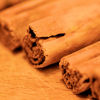
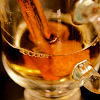



Hot Apple Toddy
1oz to 2oz applejack (or brandy, whiskey, etc.)
1 to 2 natural sugarcubes
hot water
Garnishes: cinnamon stick (preferrably Mexican canela), star anise, or other warm spices; lemon wedge, apple slice, orange peel, etc.
Place the sugar and applejack in the bottom of an Irish coffee mug. Add hot water to fill, stir to dissolve sugar, and garnish as desired.
Drink of the Week, drinks, Mixology Monday, recipes
11 Comments »




Posted by Anita on 01.11.08 7:48 AM
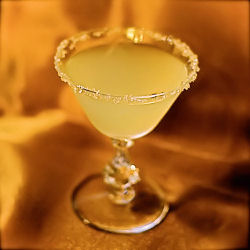 Invented in France during the years of America’s “noble experiment” with Prohibition, it’s puzzling that the Sidecar has yet to take its proper place in the modern cocktail renaissance. It’s a glorious drink when well made, but it does subject the bartender to a little bit of fuss.
Invented in France during the years of America’s “noble experiment” with Prohibition, it’s puzzling that the Sidecar has yet to take its proper place in the modern cocktail renaissance. It’s a glorious drink when well made, but it does subject the bartender to a little bit of fuss.
As with many simple drinks, the quality of the ingredients can make or break this recipe; Robert Hess does an excellent job detailing the contributions of the various components. But even when using top-shelf brands, you’ll need to do a fair bit of balancing. Brandies vary widely in strength and sweetness, and even plain-old Eureka lemons change in acidity throughout the growing season.
The traditional recipe of equal parts brandy, triple-sec, and lemon juice is very sweet, especially when served in the customary sugar-rimmed glass. Although I won’t go as far as David Embury — who rationalized that a Sidecar is simply a Daiquiri clone, and advocated a bone-dry ratio of 7:2:1 — I do think that all but the sweetest palates will prefer something closer to two parts brandy to one part each Cointreau and juice.
Like many old-time recipes, the Sidecar has undergone a dizzying list of modifications over the past 70 years. Beyond modernizing the proportions, this recipe stands up to a fair bit of tinkering. Varying the base liquor gets you a Chelsea Sidecar (gin), a Boston Sidecar (rum plus brandy), or an Applecar (Applejack). Swapping lime juice for the lemon, or tweaking Cointreau for another liqueur yields even more alternatives.

For this month’s Mixology Monday — a Brandy theme, hosted by the lovely Marleigh at over at Sloshed! — we took our inspiration from a drink we enjoyed at Cindy’s Backstreet Kitchen. The menu listed Belle de Brillet pear Cognac in place of the brandy (and you know we loves us some of that). Alas, the resulting mixture was jaw-numbingly sweet, but the concept was just too good to ignore; off we went to the home laboratory.
First we tried decreasing the sweet components: Reducing the Belle de Brillet diminished the beautiful pear essence of the drink, and halving the Cointreau flattened everything out. Starting out from the other direction, increasing the lemon juice made things too puckery. Dispensing with the sugared rim did help a bit, but it seems a shame to lose this sparkle.
At last, we turned to the Clear Creek Pear Brandy (or, better still, its sibling eau de vie in the captive-pear bottle). Hooray! We’d found plenty of pear and fruity warmth without the cloying sweetness.
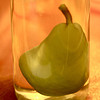
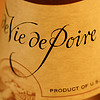
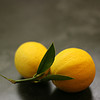
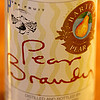
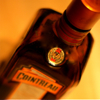

Le Side-car aux Poires
1-1/2 oz pear brandy
3/4 oz Cointreau
3/4 oz lemon juice
Before squeezing the lemon, rub the cut side along just the outside edge of a chilled cocktail glass. (Resist the urge to dip the rim in water or juice — as you see sloppy bartenders do just about everywhere — or you’ll end up with sugar inside the glass and floating in your drink.) Dip the edge into a plate of sugar, rolling to create a sugar rim.
Shake the brandy, Cointreau, and juice with ice. Strain into the prepared cocktail glass.
Drink of the Week, drinks, Mixology Monday, recipes
11 Comments »




Posted by Anita on 11.30.07 7:02 AM
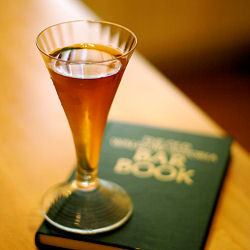 A few months ago, the New Yorker ran a ‘briefly noted’ blurb about Michael Lerner’s book Dry Manhattan: Prohibition in New York City. The review’s blasé tone must have dissuaded me from rushing out to buy a copy; instead, I patiently waited months for my chance to read our library’s single circulating print.
A few months ago, the New Yorker ran a ‘briefly noted’ blurb about Michael Lerner’s book Dry Manhattan: Prohibition in New York City. The review’s blasé tone must have dissuaded me from rushing out to buy a copy; instead, I patiently waited months for my chance to read our library’s single circulating print.
Had I known what a compelling read Dry Manhattan would be, I probably would have spent 20 bucks for the luxury of getting my hands on it sooner. True, it’s a bit scholarly, weighed down with inconvenient end-notes and a tendency toward expository repetition. But I can forgive the academic author’s shortcomings, given how entertaining the final story becomes, even when you know the ending.
Despite his geographic focus on New York City, Lerner illuminates the entire era by throwing a cosmopolitan light on the social changes that led both to Prohibition and its eventual Repeal. Although the book steers clear of drawing any overt parallels to current politics, readers who possess even a passing familiarity with modern-day prohibition movements — foie gras bans and the war on medical cannabis come to mind — will recognize plenty of eerie echoes from 80 years past. The story here makes a stark reminder of how a vocal, conservative, puritan minority swept away the freedoms of an entire country as their city-dwelling counterparts complacently boasted “it can never happen here”. Until it did… and it stayed that way for 13 long, dry years.
Honestly, it’s enough to send you straight to the bar in search of a sedative.
Perusing my library for appropriate Prohibition-era cocktails to salve my nerves, I stumbled upon a drink called the Ampersand in the Old Waldorf-Astoria Bar Book. How could I help but love a drink named after my favorite typographical glyph? (I suppose I just outed myself as a font geek. So be it.) Plus, it just sounds like a winner: Gin, brandy, sweet vermouth, plus a pair of orange-scented grace notes… What’s not to like?
But why “Ampersand”?
Although the compendium is rife with anecdotes — no great surprise, given that it was laid down by the hotel’s official historian — the origins of this particular drink’s name are lost to the mists of time. It’s possible that the typographical moniker’s a nod to Martini & Rossi, the still-popular Italian sweet vermouth, and one of the drink’s key ingredients.
Whatever the namer’s original intent, it seems particularly appropriate as cocktail bloggers around the world are celebrating both this month’s Mixology Monday & this year’s Repeal Day festivities next week. Wednesday evening, be sure to raise a glass of your favorite beverage in honor of those who fought the good fight in the 1930s, restoring the pursuit of mixological happiness to us all.
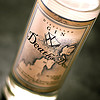
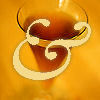


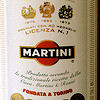
Ampersand
1 oz Old Tom gin (see note)
1 oz brandy
1 oz Italian sweet vermouth
2 dashes orange bitters
orange curaçao, to finish
In an ice-filled mixing glass, stir the gin, brandy, vermouth, and bitters until very cold. Strain into a chilled cocktail glass, then add two drops of curaçao.
Note: Old Tom was a sweetened gin of yore, a popular ingredient in many pre-Prohibition cocktail recipes. Although there are no ready sources for such a beast, fruit-derived gins such as G’vine are not bad stand-ins. Alternately, David Wondrich recommends slightly sweetened Plymouth or Junipero as acceptable substitutes; a drop or two of simple syrup seemed to do the trick in the Ampersand samples we tried. Given its lore, I suspect the original Old Tom gins were a fair deal harsher than anything on the shelves today, but we’re going for delicious approximations here, rather than slavish authenticity.
My neighbor Erik (proprietor of Underhill Lounge) was kind enough to let us sample from his personal stash of Death’s Door gin, a product that may be the closest modern Old Tom equivalent. Its flavor is noticeably sweet, a trait that the distillers assured Eric was intended rather than accidental. Alas, it’s not widely available outside the upper Midwest, but we didn’t find a drastic difference in mixed drinks made with Death’s Door compared with those made from sweetened dry gins.
bar culture, Drink of the Week, drinks, holidays & occasions, literary, Mixology Monday, other blogs, recipes
15 Comments »




Posted by Anita on 11.09.07 7:02 AM
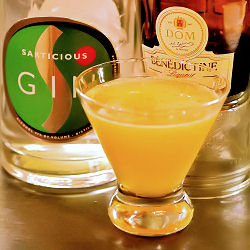 What the heck is up with all that alphabet soup in the title?
What the heck is up with all that alphabet soup in the title?
First, there’s DOTW: Drink of the Week, our regular Friday diversion into the world of mixed drinks.
And then there’s MxMo: Mixology Monday, the monthly cocktail event created by Paul Clarke. This session’s topic, Gin, is hosted (appropriately enough) by an Englishman: Jay of Oh Gosh.
DOM, though: It’s a bit of a mystery, innit? Somewhere in the depths of cocktailian history, some wiseacre decided to spread the rumor that these three letters on the label of every bottle of Benedictine stood for Dominican Order of Monks. Which is kind of ridiculous if you have even the most cursory knowledge of religious orders. For those of you without the benefit of a parochial school education, Benedictines and Dominicans are two different brotherhoods.
The whole Dominican business is one of those bits of cocktail lore that you see debunked in plenty of places. DOM, as our good Professor Embury correctly defines, is an abbreviation for the Latin phrase Deo Optimo Maximo: “To God, the best, the greatest” — a prayer on every bottle that those clever monks sent out into the sinful world.
Rather tidily, there’s a cocktail of the very same name that’s a perfect fit both for MxMo XXI and RotLC #2 (which I’m happy to announce has popped up over on The Spirit World this morning).
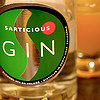
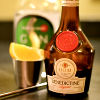

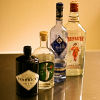
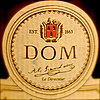
The DOM
1-1/2 oz dry gin
1/2 oz Benedictine
1/2 oz fresh orange juice
Shake all ingredients, and strain into a chilled cocktail glass.
As written, I found the DOM lacking a certain something. A splash of orange bitters brought out the Benedictine’s citrus and vanilla notes; Cameron pronounced it Creamsicle-esque, although not as sweet. Aromatic bitters highlight the gin’s bite and the liqueur’s spicy overtones — a better match, methinks. Should you find yourself in possession of a Meyer lemon, its juice makes lovely substitution for some, or all, of the OJ.
Drink of the Week, drinks, Mixology Monday, other blogs, recipes
2 Comments »




Posted by Cameron on 10.15.07 7:02 AM
 A big shout out to Natalie over at The Liquid Muse for choosing food/cocktail pairings as the Mixology Monday topic for October. My proposal for a decadent lunch (or bachelor’s dinner) is a steak and bleu cheese sandwich paired with an ice-cold Martini — one of my all-time favorite combinations.
A big shout out to Natalie over at The Liquid Muse for choosing food/cocktail pairings as the Mixology Monday topic for October. My proposal for a decadent lunch (or bachelor’s dinner) is a steak and bleu cheese sandwich paired with an ice-cold Martini — one of my all-time favorite combinations.
This is no tame, civilized snack. The sandwich should be rough and ready. You’ll need slices of cold beef left over from the loud debauchery at the grill Saturday night; a good, chewy roll; a wedge of bleu; plus a spreading knife and the guts to use it.
No lettuce. No mayonnaise. No mustard.
This particular Martini you want to be rippingly cold and (to borrow a winning concept from The Art of the Bar) made with Atomic Age proportions of gin and vermouth. Skip the orange bitters; you’ve already got a lot of flavors coming together.
Consume while watching a sporting match, taking in an action flick, or plotting your next corporate takeover.


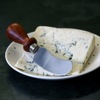

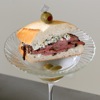
Steak and Bleu Sandwich
Cold sliced steak
Bleu cheese at room temperature
Chewy sandwich roll
Slice open roll. Spread several healthy swipes of bleu cheese on both halves. Layer bottom half with steak slices, and top with the other half. Eat.
 Atomic-Age Martini
Atomic-Age Martini
2 oz gin
1/2 oz (or less) dry vermouth
Combine ingredients in an ice-filled mixing glass. Stir until icy cold. Strain into a chilled cocktail glass, and garnish with an olive or two.
drinks, meat, Mixology Monday, other blogs, recipes
6 Comments »




Posted by Anita on 09.14.07 7:05 AM
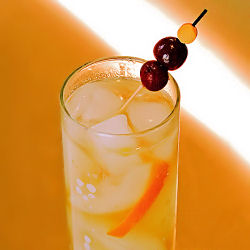 The year is 1895. In a Bordeaux village, brothers Paul and Raymond Lillet begin commercial production of a Sauternes-based elixir known as Kina Lillet. A bittersweet concoction steeped with cinchona and citrus, Lillet quickly becomes popular enough to spawn imitators, leading to an advertising campaign that encourages consumers to “avoid knock-offs.” The aperitif was (and is) often served with a citrus twist, sometimes along with ice and/or sparkling water.
The year is 1895. In a Bordeaux village, brothers Paul and Raymond Lillet begin commercial production of a Sauternes-based elixir known as Kina Lillet. A bittersweet concoction steeped with cinchona and citrus, Lillet quickly becomes popular enough to spawn imitators, leading to an advertising campaign that encourages consumers to “avoid knock-offs.” The aperitif was (and is) often served with a citrus twist, sometimes along with ice and/or sparkling water.
The same year, across the Atlantic, a gentleman by the name of George Kappeler publishes a book called Modern American Drinks, and for the first time in print describes an old-fashioned cocktail:
“Dissolve a small lump of sugar with a little water in a whiskey-glass; add two dashes Angostura bitters, a small piece ice, a piece lemon-peel, one jigger whiskey. Mix with small bar-spoon and serve…”
Fast-forward to 2007: Cocktail purists cry out against the modern practice of befouling an otherwise respectable Old Fashioned with a shot of soda water. Some highly orthodox practitioners even go so far as to ban the presence of muddled orange, advocating a return to the absolute original. I wish I had a dollar for every time I’ve heard a cocktail geek declare the Old Fashioned their litmus test of a bartender’s skill, their canary in a cocktail coal-mine. Even the merest splash of fizz is enough to send them running out the door, or at least huddling behind the safety of the beer list.
I’m with these libational Luddites, at least most of the way. But I find a touch — not a hearty glug — of soda a pleasant lightening agent in an Old Fashioned. Omitting the orange seems a tad austere for my palate; even the otherwise old-school DrinkBoy admits that the citrus adds “some useful and interesting flavors”. Rye is my whiskey preference here, but I will not deny a well-made bourbon variation, or even scotch in a pinch. In the realm of cocktail snobbery, I’m not quite Orthodox. I’m also a fan of tinkering with tradition, of using the classics as a springboard for modern variations.
So imagine my amusement with this entry on the drinks list at Downtown, a popular pre-theater stop across the bay in Berkeley:
Fashionably Lillet: Sugar cube, a slice of orange, brandied cherry & a dash of bitters muddled together with Lillet, served tall and cool with soda.
Hey there, that’s a clever hybrid of the continental Lillet & Soda and the all-american Old Fashioned. I’ve got no way of knowing if the bartender was poking good-natured fun at the soda-scoffing set, but the name alone tells us she’s got a sense of humor.
Amused at the idea, I order one up. Alas, the pint-glass concoction I’m served falls a bit short of the mark. Lillet’s a fairly mellow aperitif, after all, and even with plenty of ice, 16 ounces of headroom means the drink ends up tasting like lightly flavored soda water. It’s also unwieldy, so much so that the straw isn’t just a clever summery touch, but a necessity. And then there’s all that muddled fruit in the glass, which gums up the straw.
Back at home, we fiddle with the ingredients and try to come up with a solution. We futz with proportions, with glassware, with preparation methods, and with ratios, all without success. We set the recipe aside, and go about our summer.
This month’s Mixology Monday theme — Fizz, hosted by Gabriel at cocktailnerd — seemed like a good excuse to take another pass. While reading up on Old Fashioned history, a line in Robert Hess’s highly opinionated recipe post catches my eye:
“…the maraschino cherry doesn’t really add anything at this [muddling] stage besides a mangled carcass and a little bit of extra sugar…”
Hmm. He’s onto something there. The next time through, I leave out the cherry, saving it for garnish. The resulting drink is better, but still fairly weak. Adding more Lillet — the natural route to a stronger cocktail — makes the drink one-dimensional; the aperitif’s mildness, in this case, is no asset.
Suddenly, the solution becomes obvious: It’s a riff on an Old Fashioned, after all — why not a splash of rye? (Bourbon could work, but I’m trying to keep the sweetness in check.) It may have taken all summer, but I’m happy with the final mix: A light, summery cooler with a nod to both sides of The Pond.
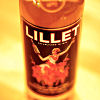
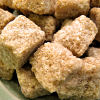
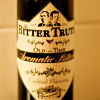


Fashionably Lillet
– adapted from Downtown
 1 cube natural sugar
1 cube natural sugar
1 orange slice, halved (divided use)
3 dashes aromatic bitters
1/2 oz rye or bourbon
2-1/2 oz Lillet blanc
3 oz soda water
brandied cherries, for garnish
Fill a highball glass with ice, arranging half of the orange slice among the cubes; set aside. In a mixing glass, muddle the sugar, half of the orange slice, and bitters together. Add the rye and the Lillet, and top with ice. Stir until well chilled, then strain into the prepared highball. Top with soda, and garnish with brandied cherries.
Drink of the Week, drinks, Mixology Monday, recipes
12 Comments »




Posted by Anita on 08.10.07 7:08 AM
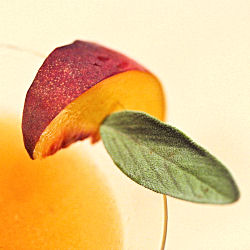 Last year, I put myself on a book diet. Watching my ever-expanding kitchen library take over the countertops, I knew the time had come for serious change. I still allowed myself to purchase cookbooks, but only after thoroughly vetting them first. Usually, this involved borrowing the book from a friend, or from the public library.
Last year, I put myself on a book diet. Watching my ever-expanding kitchen library take over the countertops, I knew the time had come for serious change. I still allowed myself to purchase cookbooks, but only after thoroughly vetting them first. Usually, this involved borrowing the book from a friend, or from the public library.
Even though it’s been difficult to curb the urge to acquire every buzz-worthy title on the market, the system that I fondly call “the new cruelty” has saved me from buying more than a few turkeys. The number of additions to our library has been small, but every one of them gets used regularly.
My real problem, though, was bar books. I’m the abashed owner of what any normal foodie would consider to be an unseemly quantity of cocktailian tomes. Given the vast amounts of spiritous inspiration lurking around every corner of the Internet, my hoard has proven truly unnecessary. In the strictest sense, most mixology manuals aren’t even all that inspirational — they often lack photos, and they’re typically burdened either by purple prose or too-clinical content. Enough, I said, was enough.
So while everyone else swooned over The Art of the Bar during its debut, I smugly folded my arms and turned my head. I have plenty of drinks books, I told myself. Besides, I’m not even that fond of Absinthe (the authors’ place of employment, that is, not the aperitif).
But one afternoon with some time to kill between mid-day appointments, I found myself in front of a local bookstore. I popped inside and headed down to the cookbook department. Grabbing a few titles and heading to the nearest bench, I was sucked into to The Art of the Bar by beautiful full-page photos, artfully styled but still obviously real. The copy was engaging, and the recipes — I grudgingly admitted — were interesting without being too “out there”. In short, it was the cocktail book I could justify buying.
But still I stood my ground for months, even after discovering that the San Francisco Public Library — quite scandalously — does not own a copy of this widely acclaimed title (all the more amusing because you could almost hit Absinthe with a muddler thrown from the roof of the Main Library). After finally scrounging a copy through interlibrary loan, it didn’t take more than a few test drinks to know that my moratorium would crumble.
Living with one of the world’s most unrepentant punsters, it’s not surprising that one of the first recipes I flagged was a little number called Peaches & Herb. Stone fruits had just burst into season as my very own copy arrived on our doorstep, and the new sage plant was thriving — truly, my path was clear.
We’ve been mixing up a batch of these beauties almost every week for the last month, trying little variations here and there. You’ll be pleased to know that orange bitters, or even Angostura, can take the place of the requested peach bitters (although the original is undeniably better).
This month’s edition of Mixology Monday asks us to think orange — and the lovely P&H qualifies twice, both by virtue of its sunny color and one of its key ingredients. Even if you’re colorblind you’ll definitely want yellow peaches here; their white siblings clash with sage’s herbal intensity. And although brandy makes for some mighty smooth sipping, I’d be remiss if I didn’t recommend bourbon as a tremendously interesting variation.


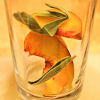


Peaches & Herb
– from The Art of the Bar, by Jeff Hollinger & Rob Schwartz
3 to 4 slices of peach, plus 1 slice for garnish
3 to 4 fresh sage leaves, plus 1 leaf for garnish
splash of simple syrup
1-1/2 oz brandy (or bourbon)
1/2 oz Cointreau orange liqueur
2-3 dashes peach bitters
1/4 oz lemon juice
 In a mixing glass (or cocktail shaker), muddle the peach and the sage with the syrup (if needed, depending on the sweetness of the peach), to make a pulp. Top with ice; add the brandy, Cointreau, bitters, and lemon juice. Shake your groove thing until cold, and strain into a chilled cocktail glass; garnish with remaining peach slice and sage leaf.
In a mixing glass (or cocktail shaker), muddle the peach and the sage with the syrup (if needed, depending on the sweetness of the peach), to make a pulp. Top with ice; add the brandy, Cointreau, bitters, and lemon juice. Shake your groove thing until cold, and strain into a chilled cocktail glass; garnish with remaining peach slice and sage leaf.
cookbooks, Drink of the Week, drinks, Mixology Monday, recipes
10 Comments »




Posted by Anita on 07.13.07 7:04 AM
 When I read Jeffrey Morgenthaler’s recent post outlining his list of Dos and Donts of Mojitos, I found myself nodding in vigorous agreement. When I got to this entry, I broke into a wide grin:
When I read Jeffrey Morgenthaler’s recent post outlining his list of Dos and Donts of Mojitos, I found myself nodding in vigorous agreement. When I got to this entry, I broke into a wide grin:
“Do not order a mojito when the weather is below 70°F. This is almost as bad as ordering a Bloody Mary after the sun has gone down.”
Hear, hear.
I can’t tell you how many winter nights I’ve spent at the Zig Zag watching Murray Stenson painstakingly craft mojitos for some clueless clown. The phenomenon became so epidemic a few years ago that Cameron and I were moved to concoct an alternative, off-season rum drink for Murray to offer. (It’s an amateurish thing called the Wonderland — as in “Walking in a Winter…” and Murray graciously humors us by keeping the recipe in the box behind the bar.)
It’s hard to fault a mojito aficionado from defying the seasonal mandate at the Zig Zag, because when it comes to mojito-making, Murray’s method is a sight to behold. Cameron likes to remark that Murray puts more love into a single cocktail than most restaurants put into a whole meal, and I am convinced that he was witnessing a mojito-muddling marathon for the first time when he coined that oh-so-true aphorism.
As Morgenthaler correctly cautions, a mojito is no drink to order when your fellow tipplers are three-deep at the bar. Even the most slap-dash mojito is a time-consuming order. But making ‘Mojitos a la Murray’ elevates the procedure to high art.
Murray starts out by cutting half a lime into quarters, placing the pieces in a pint glass with half a dozen mint leaves and simple syrup. Crushed ice is added, and muddling commences. Six more mint leaves join the party, along with another dose of syrup and more ice. More muddling. Another dose of mint — this time sans syrup — and still more muddling. Then the rum, and a purposeful stir while surveying the bar. Tasting for balance, he tinkers with his creation until he achieves the ideal balance of sweet, sour, and strength; it rarely needs much to bring it to perfection. Out of his pile of mint, he chooses one more perfect sprig, dusting it with a flurry of powdered sugar before placing it jauntily in the glass, and handing the drink over to the suitably awed customer.
Both Murray and Jeffrey adhere to the unstrained school of mojito mixology: “I leave the ‘salad’ in place,” says Mr. Stenson. My muddling technique must be a bit weak; I haven’t yet mastered the fine art of extracting sufficient mint flavor without creating a pulpy mess, even when using Murray’s step-by-step directions and the prescribed copious amounts of greenery. So, as a compromise, I follow the ‘Murray Method’ right up to the end, but then strain the muddled mixture into an ice-filled cooler glass. A few small bits of mint find their way through the strainer, creating a pleasantly herb-flecked drink with plenty of punch.
Murray also dispenses with the traditional top-up of soda water; his masterful muddling provides the just the right opportunity for dilution. I like a bit of fizz, myself (as does Morgenthaler), but let your cocktail conscience be your guide on this point, as always.

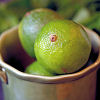
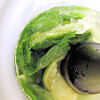
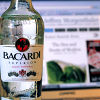

Mojito
1/2 lime
1T simple syrup, or to taste
18 medium mint leaves, plus a sprig for garnish
2 oz silver rum
good-quality soda water (optional)
confectioners sugar (optional)
Cut the lime-half into quarters, and muddle in a 16-oz glass along with 6 medium mint leaves and 1/4 ounce (1-1/2 tsp) simple syrup. Add crushed ice to one quarter of the way up the glass. Add 6 more mint leaves and another 1/4 ounce simple syrup; muddle again. Add crushed ice to a level about 2/3 up the glass, plus remaining 6 mint leaves (no simple syrup this round); muddle yet again. Add the rum and stir until the glass begins to frost. Adjust to taste, then strain the chilled mixture into an ice-filled 12-ounce highball or cooler glass. Top up with a splash of soda water, if desired. Garnish with a sprig of mint, dusted with confectioners sugar, if desired.
bar culture, Drink of the Week, drinks, Mixology Monday, other blogs, recipes
17 Comments »




 A month or so ago, at last unable to ignore the murmurs of delight circulating around the cocktail world, we sought out a bottle of Rhum Clément Creole Shrubb, an orange liqueur from Martinique. Made by infusing a blend of white and aged rums with spices and bitter orange peels, Creole Shrubb turns out to be quite different from the usual, more-neutral orange liqueurs. Its complexity intrigued us, but because we knew its dusky mysteriousness would make it an imperfect match for existing recipes, the Creole Shrubb languished on our “try me” shelf.
A month or so ago, at last unable to ignore the murmurs of delight circulating around the cocktail world, we sought out a bottle of Rhum Clément Creole Shrubb, an orange liqueur from Martinique. Made by infusing a blend of white and aged rums with spices and bitter orange peels, Creole Shrubb turns out to be quite different from the usual, more-neutral orange liqueurs. Its complexity intrigued us, but because we knew its dusky mysteriousness would make it an imperfect match for existing recipes, the Creole Shrubb languished on our “try me” shelf.






 Mercifully, many of these voluminous drinks come equipped with two or more straws, and most are expressly designed to be shared by gregarious group of cocktail hounds. Among this genre, the best known — and possibly the most confusingly varied — is the Scorpion Bowl. Back in the tiki heyday of the 1950s, it seemed like every bartender had his own scorpion style; some stuck with the arguably original
Mercifully, many of these voluminous drinks come equipped with two or more straws, and most are expressly designed to be shared by gregarious group of cocktail hounds. Among this genre, the best known — and possibly the most confusingly varied — is the Scorpion Bowl. Back in the tiki heyday of the 1950s, it seemed like every bartender had his own scorpion style; some stuck with the arguably original 





































 Atomic-Age Martini
Atomic-Age Martini





 1 cube natural sugar
1 cube natural sugar Last year, I put myself on a
Last year, I put myself on a 




 In a mixing glass (or cocktail shaker), muddle the peach and the sage with the syrup (if needed, depending on the sweetness of the peach), to make a pulp. Top with ice; add the brandy, Cointreau, bitters, and lemon juice.
In a mixing glass (or cocktail shaker), muddle the peach and the sage with the syrup (if needed, depending on the sweetness of the peach), to make a pulp. Top with ice; add the brandy, Cointreau, bitters, and lemon juice.  When I read Jeffrey Morgenthaler’s recent post outlining his list of
When I read Jeffrey Morgenthaler’s recent post outlining his list of 



